Motorola Razr (2025) intro
You get a slightly smaller inner and outer screens in comparison with the Ultra and the Plus, as well as a slightly humbler MediaTek chip, a slightly less capable camera system and slower charging. All of that is normal to expect from a foldable phone that goes for $700.
Other than that, everything else is pretty decent value.
As evident, the phone suffers due to the lower scores in performance and camera. Still, it’s not that bad, as it has many other strengths as well.
Table of Contents:
Motorola Razr (2025) Specs
Humbler than its peers
Here is an overview of the Motorola Razr (2025) specs:
| Motorola Razr (2025) |
Motorola Razr Plus (2025) |
Motorola Razr Ultra (2025) |
|---|---|---|
| Size and Weight Open: 74 x 171.3 x 7.25 mm Closed: 74 x 88.1 x 15.9 mm 188gr |
Size and Weight Open: 74 x 171.4 x 7.1 mm Closed: 74 x 88.1 x 15.9 mm 188 g |
Size and Weight Open: 73.99 x 171.48 x 7.19mm Closed: 73.99 x 88.12 x 15.69mm 199g |
| Display Main: 6.9″ Foldable AMOLED up to 3,000 nits External: 3.6″ pOLED |
Display Main: 6.9″ Foldable AMOLED up to 3,000 nits External: 4″ pOLED |
Display Main: 7″ Foldable AMOLED up 4,500 nits brightness External: 4″ pOLED |
| Processor MediaTek Dimensity 7400X |
Processor Snapdragon 8s Gen 3 |
Processor Snapdragon 8 Elite |
| Cameras 50MP main, f/1.7 13MP ultra-wide, f/2.2 32MP front |
Cameras 50MP main 50MP 2X telephoto 32MP front |
Cameras 50MP main, f/1.8 50MP ultra, f/2.0 50MP front |
| Battery Size 4,500 mAh |
Battery Size 4,000 mAh |
Battery Size 4,700 mAh |
| Charging Speeds 30W wired 15W wireless |
Charging Speeds 45W wired 15W wireless |
Charging Speeds 68W wired 30W wireless |
| Prices: $700 for 8/256GB |
Prices: $1,000 for 12/256GB |
Prices $1,300 for 16/512GB |
Motorola Razr (2025) Design and Display
Budget foldables have never looked better


(Image by PhoneArena)
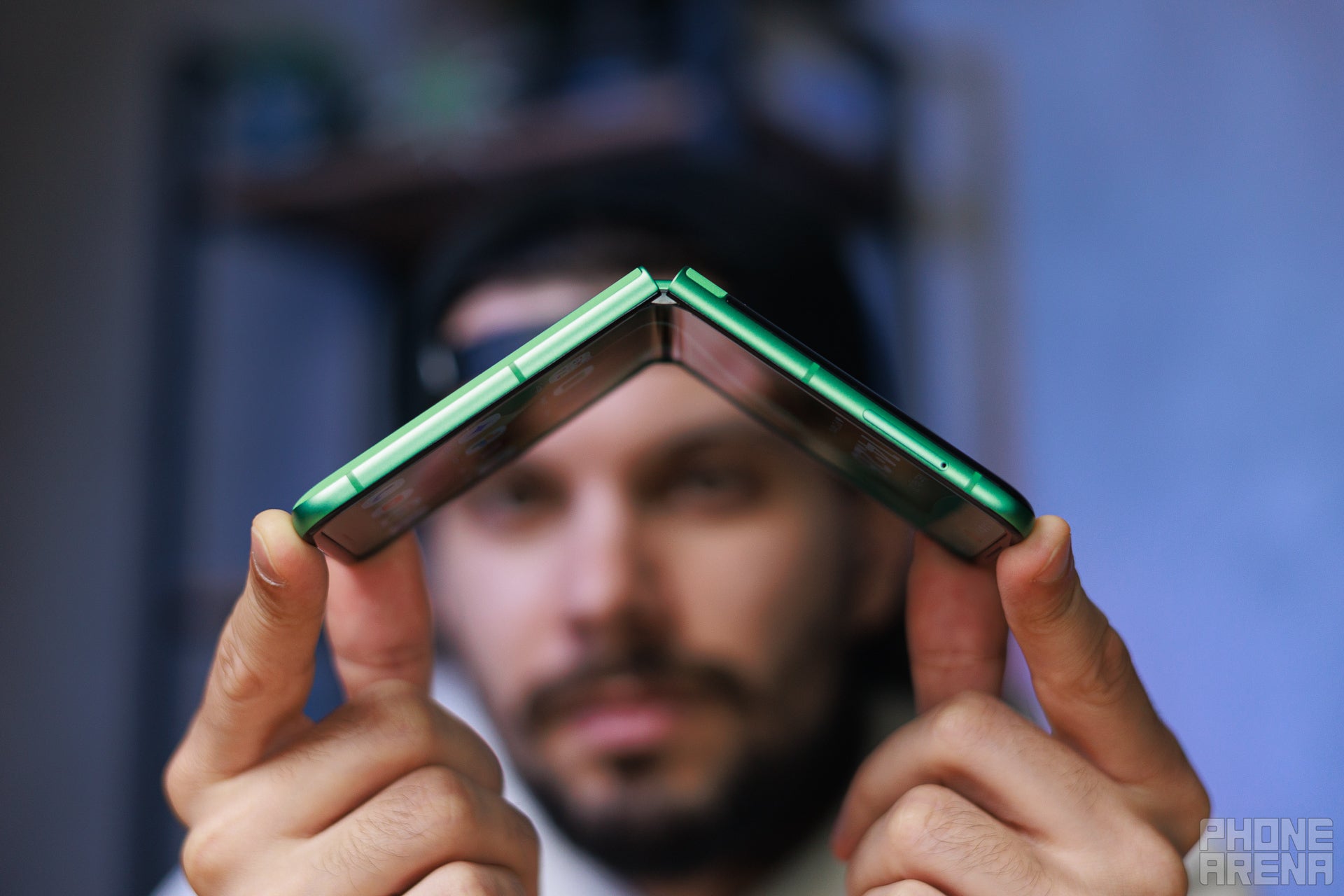

With a stylish aluminum frame, vegan leather or nylon-inspired acetate rear plate, this phone is unmistakably Razr. The hinge is just as robust as the one on last year’s Razr, allowing you to position the phone in different configurations, which wasn’t exactly the case with some older Razr foldables.
Aside from that, the phone is light enough at 188 gr, just as much as the Razr Plus (2025) and the Galaxy Z Flip 6. It feels fairly comfortable in the hand, and it’s a joy using it.
The Motorola Razr 2025 is outfitted with IP48 water and dust protection, just like the Galaxy Z Flip 6. This should give a peace of mind in most life situations, but always have in mind about the “4” digit in the IP48 designation: while it means the device is protected from particles larger than 1mm, dust and sand may still find their way inside the hinge and potentially damage it, so be mindful of where you put your device.
- the Motorola Razr (2025) itself;
- USB Type-C cable
- SIM ejector tool
- Manuals and leaflets
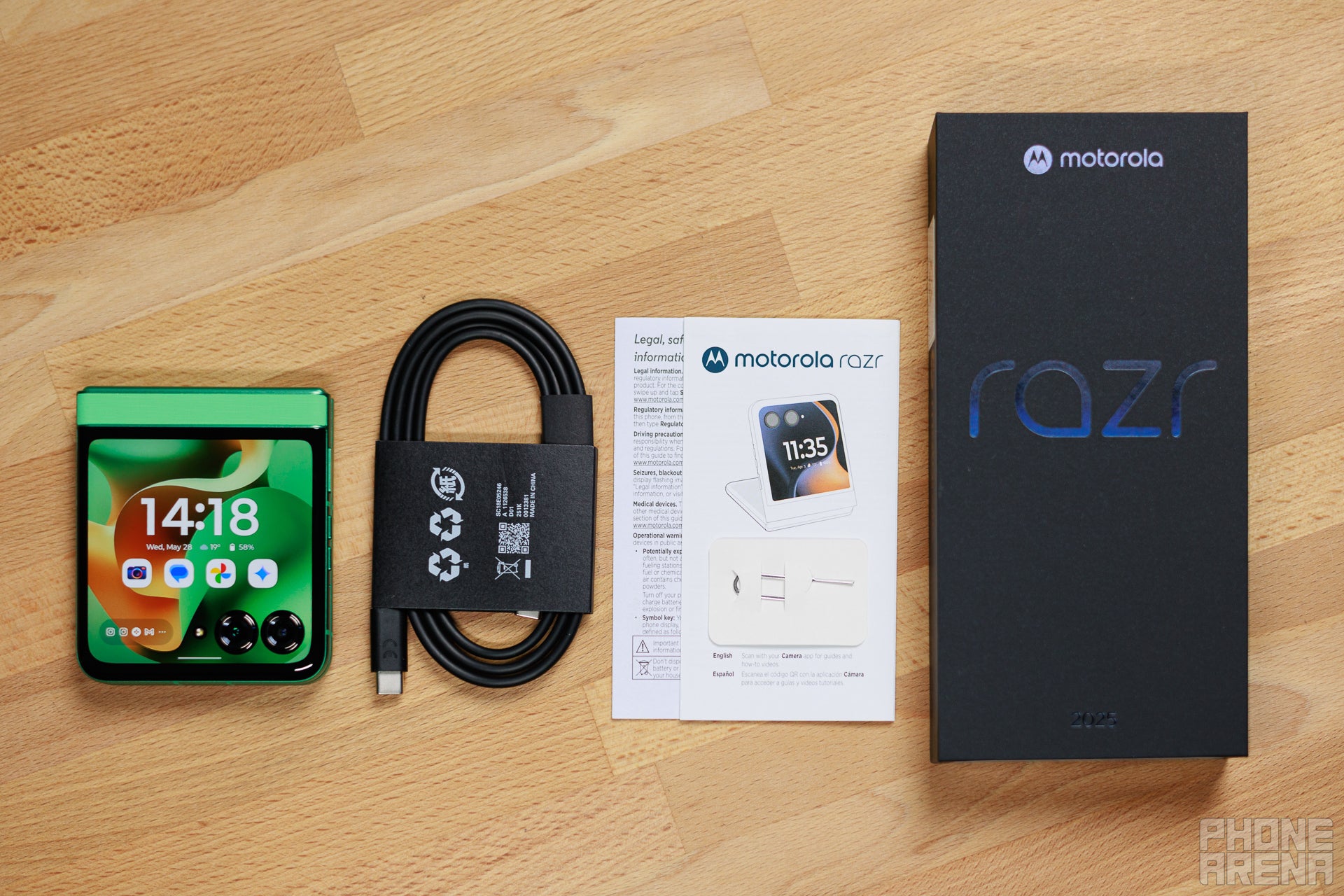

(Image by PhoneArena)
Display-wise, we get a 6.9-inch internal screen, an OLED one with FHD+ resolution and up to 120Hz or smooth refresh rate and 120% coverage of the DCI-P3 color gamut. There’s a slight crease on the display, but nothing out of the ordinary. The screen is super-sharp and vivid, so it’s a joy to look at!
The external screen is a 3.6″ OLED one, only interrupted by the dual camera cutouts. It’s slightly larger than the Galaxy Z Flip 6‘s 3.4-inch screen, but smaller than the Razr Plus‘ 4-inch display. It’s an LTPS panel, meaning that it can only go up to 90Hz, so not as smooth as the inner screen. The peak brightness is also lower, only capable of hitting 1700 nits in high-brightness mode.


Excellent inner screen (Image by PhoneArena)
According to our in-house benchmark readings, the main display of the Razr can achieve 2,000 nits of peak brightness, which is just about enough to ensure good outdoor legibility. The Razr Ultra (2025) and the Galaxy Z Flip 6 are significantly brighter at around 2,400 nits measured, so you will have a better experience with those two.
The fingerprint scanner on the phone is embedded right into the side-positioned power button. It’s an old-school capacitive fingerprint scanner, and you can’t really argue with that: it is fast and accurate and just works.
Motorola Razr (2025) Camera
Ultra-wide is in, telephoto is out
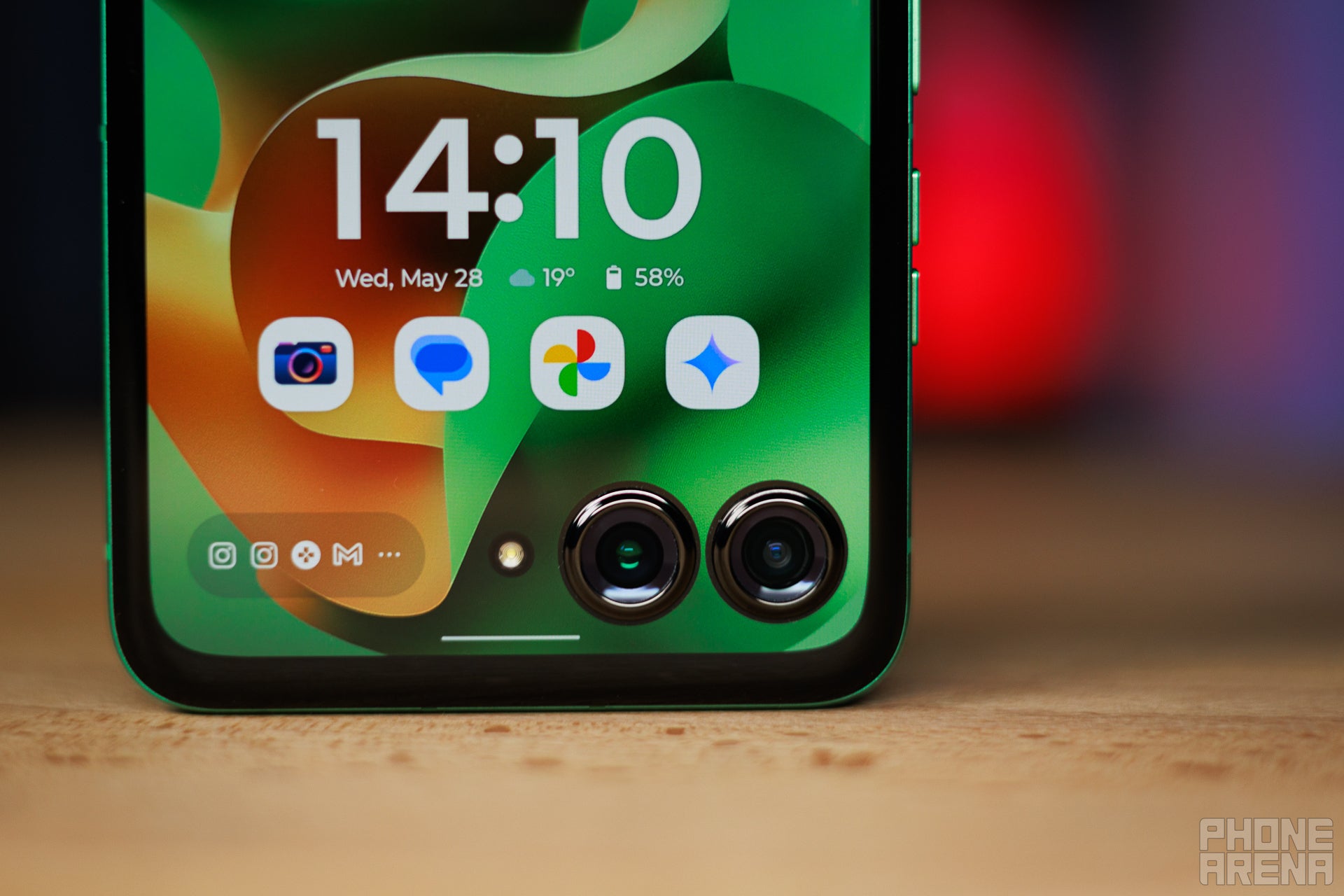

(Image by PhoneArena)
The Motorola Razr (2025) comes along with two cameras, a 50MP main and a 13MP ultrawide, a setup very similar in terms of hardware to the Galaxy Z Flip 6. The inner screen houses a large 32MP sensor that’s perfect for selfies.
However, the overall capabilities of the Razr’s camera aren’t spectacular, as evident from the results in our camera benchmark above. With a cumulative score of just 125, it falls far behind the other current Motorola foldables as well as the Galaxy Z Flip 6. The phone mostly struggles in terms of video-recording, where the phone struggles.
Here are some camera samples to drive our point across.
Main Camera
The main camera is fairly competent, all things considered, delivering strong performance in overall and subject exposure. The color temperature is also very decent, but the detail is somewhat disappointing due to the oversharpening that sours the soup.
Zoom Quality


2X zoom
Zoom is digital past the native 1X point, and the quality is fairly good at 2X, with very usable results at this point. Some oversharpening is present here, but detail is fairly clean.
However, as evident in the samples above, the more you zoom in, the worse results you get. At 10X, the images are barely usable. We’d say 4X is the maximum you should zoom in here.
Ultrawide Camera
Selfies
While you can take a selfie with the rear camera setup, the inner front camera is mighty capable, delivering lovely and true-to-life colors, especially in the facial area, good dynamics, and some decent sharpness.
Video quality

While the video quality is okay, zooming in will disappoint. The stabilization is very good, but this is probably the strongest upside here. Dynamic range and detail definitely are lacking in comparison with other phones.
Motorola Razr (2025) Performance & Benchmarks
Disappointing
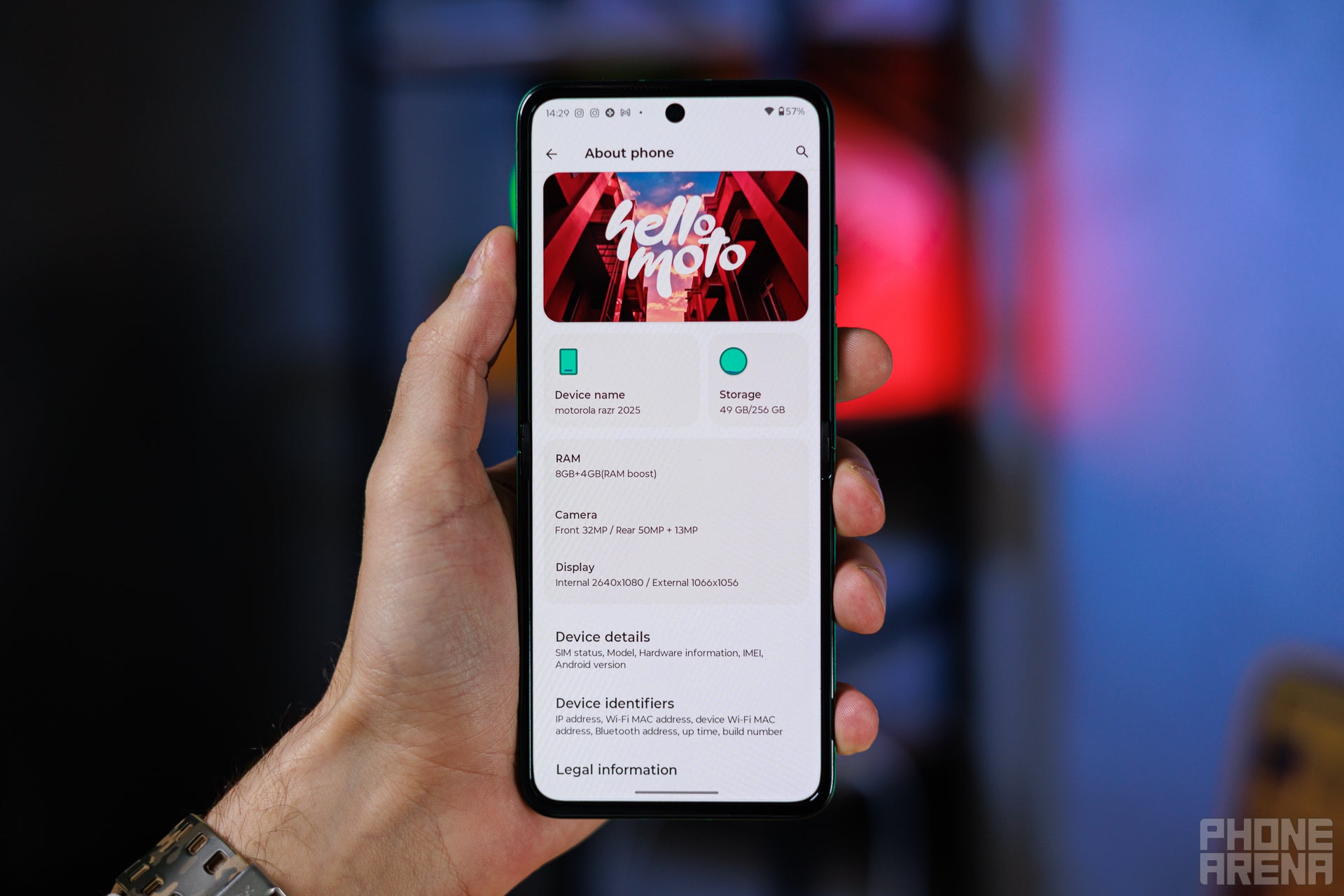

(Image by PhoneArena)
Inside the Motorola Razr (2025), one would find the 4nm MediaTek Dimensity 7400X, a fairly new octa-core mid-range chipset that’s a perfect fit for an affordable device of the Motorola Razr’s caliber.
However, from a performance standpoint, this MediaTek is a far cry from proper flagship chips like the Snapdragon 8 Ultra inside the Razr Ultra, binned or not. While the regular Razr will perform more than acceptable in most tasks, you will notice a difference in heavier tasks and especially in gaming.
CPU Performance Benchmarks:
GPU Performance
Gaming on the Razr is an okay experience, provided that you tone down your expectations and don’t play very heavy and demanding games. There are much better options if you’re a devoted gamer.
The phone comes with 8GB of LPDDR4X RAM and 256GB of UFS2.2 storage. Both the memory and the storage are utilizing ancient speed standards, which is somewhat disappointing to see. The UFS 2.2 storage, in particular, is not very snappy, leading to noticeable loss in overall performance during loading a game, an app, or working with large files.
Motorola Razr (2025) Software
We get Android 15 on the Motorola Razr (2025), which is a fairly stock-ish take on Android, but sprinkled with the familiar Moto features on top. Among those are the useful Moto Actions that let you activate certain features with gestures, and other useful additions to the interface.
Interesting here is the Moto AI on board, which you can access by double-pressing the power button. Interestingly, the new Motorola Razr Ultra sports a dedicated AI key, but it’s absent here on the regular Razr.
The outer screen is very functional. You can customize its overall appearance (fullscreen or a cutout), personalize it with various styles and wallpapers, but the biggest quality-of-life feature here is the ability to access most of the apps on your phone without having to open it.
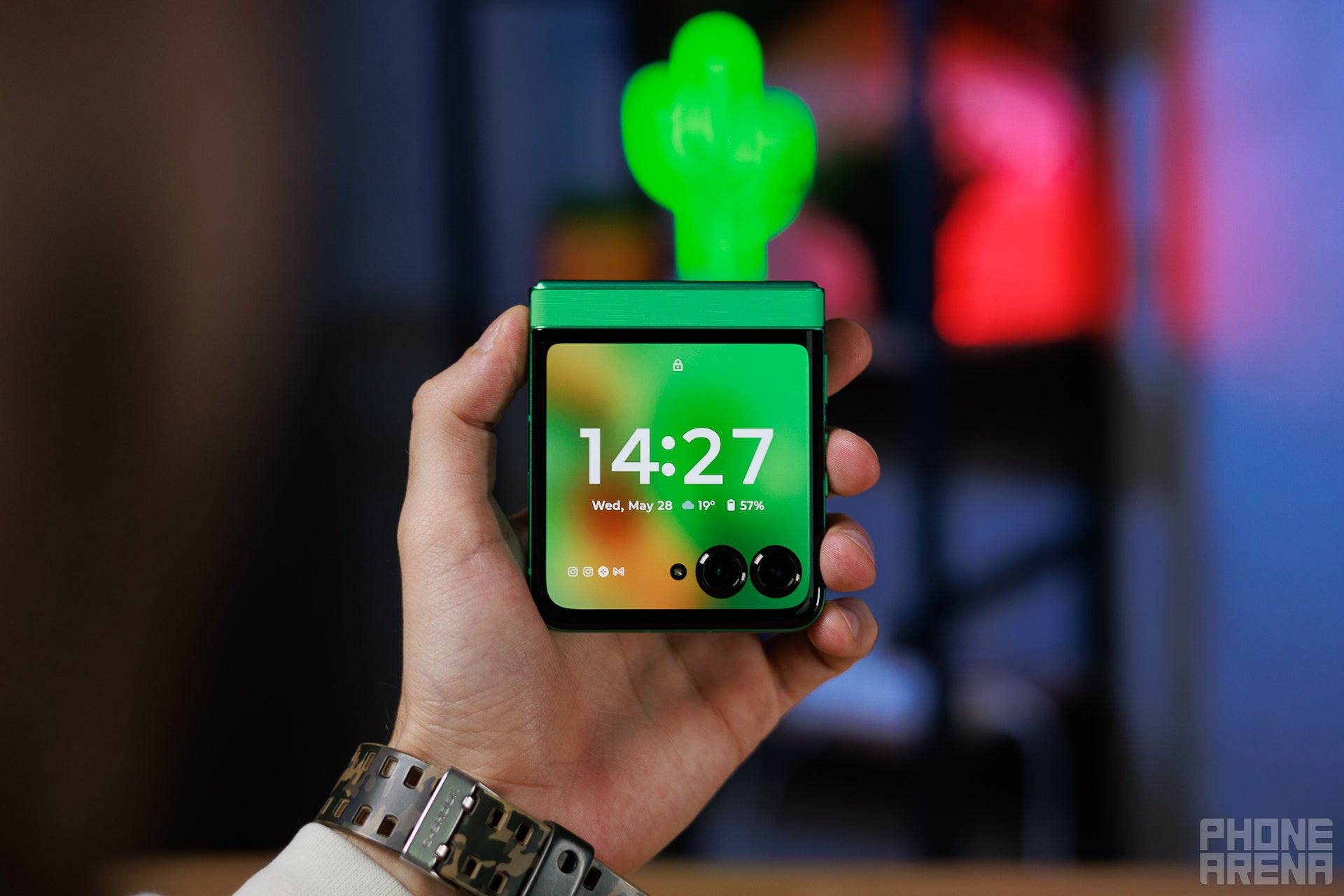

Motorola AI is here
What’s new this year is the addition of AI into the interface:
A double-press of the power button provides access to the following features.
- Catch me up, which gives you a summary of your notifications (unless you have tons of missed notifications, I found it useless)
- Pay attention (starts a voice note recording with an AI summary)
- Remember this (captures a screenshot with an AI summary)
- Magic Canvas (generates an image in one of 10 different styles like Cartoon, Fantasy, Sci-Fi, Realistic and more)
These AI-annotated screenshots and voice notes are saved in the new Journal app, which is a mix between the Screenshots app on Pixel phones and the Essential space on Nothing Phones. We are not sure if we are going to use that Journal app a lot, since taking these AI screenshots takes a bit more time and a couple of extra taps, so we actually used the regular screenshot features more. But we don’t completely discount the idea.
Among these features, we found the Magic Canvas the most impressive just because of the sheer speed of image generation (much faster than others), but that might be because it’s a brand-new platform and as more users join in, the speed could drop.
Unfortunately, you cannot feed the Magic Canvas your own images to create AI variations of them, and of course, it is not as powerful as the leading image generators, so you don’t have total creative freedom. In other words, you cannot tell it to just generate you an image in the Studio Ghibli style, which is quite popular.
Motorola Razr (2025) Battery
Unimpressive battery life
The Razr comes with a 4,500mAh battery, which is marginally smaller than the Razr Plus and the Ultra, but also larger than the 4,000mAh battery inside the Galaxy Z Flip 6, for example.
However, the MediaTek chip inside apparently isn’t very efficient, as the marriage between the chipset and this particular battery has not resulted in any magic. The Motorola Razr (2025) achieves a cumulative battery life of six hours and a half in our battery life estimate, which isn’t particularly good and well below the average of seven hours.
PhoneArena Battery Test Results:
The phone fares mostly okay in our video playback test, where it lasted for nine hours and a half, but disappointingly, lasts significantly less than most other phones we’ve tested in our 3D gaming test.
In terms of charging, the phone supports 30W wired and standard 15W wireless charging. Not superfast, but manageable.
The Motorola Razr (2025) takes 55 minutes for a full charge, which is pretty much a middle-ground result. The Ultra charges significantly faster, but the Galaxy Z Flip 6 is much slower, so another golden point in this phone’s book of merit.
Motorola Razr (2025) Audio Quality and Haptics
The speakers lack bass and are noticeably tinny. They have a pronounced midrange, so will do you well for talking head videos, but you won’t be enjoying your music through those.
The haptics are a strong, tight vibration — not a click. However, it’s still accentuated, on point, and delivers pleasing feedback.
Overall good, but lacking that extra touch that separates flagships from mid-range devices and usually gets cut off for cost-saving reasons.
Should you buy it?


Another excellent alternative to the Galaxy Z Flip 6 (Image by PhoneArena)
The Motorola Razr (2025) is a phone that delivers immense value. At $700 for the only available version with 8GB RAM and 256GB of memory, the Razr is definitely the phone to consider if you’re on a tight budget.
To achieve such a price tag, some corners had to be cut. Well, the main weaknesses here are the overall performance of the phone’s MediaTek chip and slow storage and memory. The camera quality also fails to make a particularly strong statement, both in still photography and video-recording. The battery life is okay, but won’t “wow” you, that’s for sure.
Overall, it’s a foldable phone for those who aren’t really concerned about having the best specs around.
👇Follow more 👇
👉 bdphone.com
👉 ultractivation.com
👉 trainingreferral.com
👉 shaplafood.com
👉 bangladeshi.help
👉 www.forexdhaka.com
👉 uncommunication.com
👉 ultra-sim.com
👉 forexdhaka.com
👉 ultrafxfund.com
👉 bdphoneonline.com
👉 dailyadvice.us


